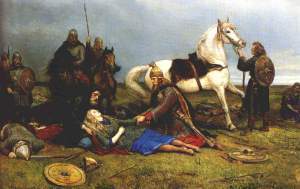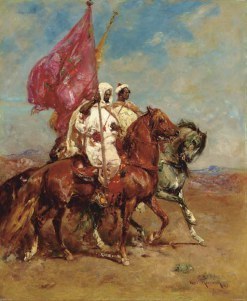Three Facts You Didn’t Know About the Vikings
According to findings, women had defined roles in knitting and cooking, but also in managing thralls (slaves) and running the farm. If a woman’s husband were away for war or raiding, she also took the role of defender of the land and would have taken up arms to defend that land if attacked. Upon a warrior’s death, his land and belongings went to his wife who had no real obligation to remarry and therefore could, if she so pleased, take over her late husband’s role as the head of household. If a warrior and his wife died without a male heir, the land and property would be passed on to the eldest child regardless of gender. The reason the Vikings gave their land to their wives upon their death is because a marriage in Scandinavia was a contract in which both parties entered as equals. All material possessions were recognized as given to the newlywed wife for protection.
Sources:
- Jochens, Jenny M. Women in Old Norse Society. Ithaca: Cornell University Press. 1995.
- Macnamara, Jo Ann and Suzanne Wemple. “The Power of Women through the Family in Medieval Europe, 500-1100.” in Clio’s Consciousness Raised: New Perspectives on the History of Women. eds. Mary Hartman and Lois Banner. New York: Harper & Row, 1974.
Fact 2: The Vikings sometimes used ships as roofs in winter.
There is mention in the Russian Primary Chronicle and select other sources that during long stays in the East, the Rus sometimes flipped their ships and used them as the roofs of temporary buildings. This was most common during trade meetings, and they did not stay long. The practice earned them the name of warrior-tradesmen among the Slavs who never knew if the Rus came to trade or raid.
Sources:
- Blöndal, Sigfús. The Varangians of Byzantium. London: Cambridge. 1978.
- Ellis-Davidson, Hilda Roderick. The Viking Road to Byzantium. London: George Allen & Unwin. 1976.
- Holthoer, R. Birch-Bark Documents from Novgorod Relating to Finland and Scandinavia. Acta Universitatis Uppsaliensis 19. Uppsala: University of Uppsala. 1981.
Fact 3: The Vikings Nearly caused the utter annihilation of Christianity in Iberia.
When most people think of Spanish history, they tend to remember the Moorish conquests, the reconquista, El Sid, etc… Rarely are the Vikings evoked. However, the Vikings were heavily present in Spain (as well as pretty much everywhere in the known world at that time) and affected the social-political didactic that existed there in the early 9th century. In fact, a Viking raid on Seville in 844 AD, which was under Moorish control, prompted the Caliph of Cordoba to militarize more aggressively. This further militarization put the weak Christian kingdoms in the region of Asturias at risk for disappearing. Luckily for the Asturians, the Vikings continued to attack islamic cities as far as North Africa, which kept the Moors of Spain preoccupied to the south.
Sources:
- Stefansson, Jon, “The Vikings in Spain. From Arabic (Moorish) and Spanish Sources.” In Saga-Book of the Viking Club: Vol. VI Proceedings. University of London King’s College, 1909.







